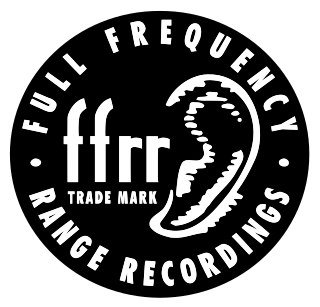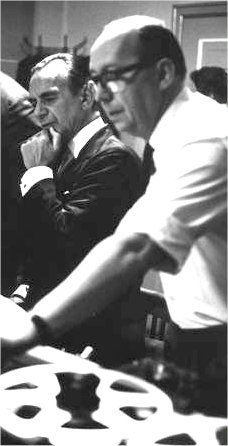
Decca Records is a British record label established in 1929 by Edward Lewis. Its US label was established in late 1934 by Lewis, Jack Kapp and Milton Rackmil, who later became American Decca's president too. In 1937, anticipating Nazi aggression leading to World War II, Lewis sold American Decca, and the link between the UK and US Decca label was broken for several decades. The British label was renowned for its development of recording methods, while the American company developed the concept of cast albums in the musical genre.

Leopold Anthony Stokowski was a British-born American conductor. One of the leading conductors of the early and mid-20th century, he is best known for his long association with the Philadelphia Orchestra. He was especially noted for his free-hand conducting style that spurned the traditional baton and for obtaining a characteristically sumptuous sound from the orchestras he directed.
RCA Records is an American record label owned by Sony Music Entertainment, a subsidiary of Sony Corporation of America.

Quadraphonic sound – equivalent to what is now called 4.0 surround sound – uses four audio channels in which speakers are positioned at the four corners of a listening space. The system allows for the reproduction of sound signals that are independent of one another.

London Recordings is a British record label that marketed records in the United States, Canada, and Latin America for Decca Records from 1947 to 1980 before becoming semi-independent. The London name – as London American Recordings, often shortened to London American – was also used by British Decca in the UK market, for releases taken from American labels, which British Decca licensed.

MGM Records was a record label founded by the Metro-Goldwyn-Mayer film studio in 1946 for the purpose of releasing soundtrack recordings of their musical films. It transitioned into a pop music label that continued into the 1970s. The company also released soundtrack albums of the music for some of their non-musical films as well, and on rare occasions, cast albums of off-Broadway musicals such as The Fantasticks and the 1954 revival of The Threepenny Opera. In one instance, MGM Records released the highly successful soundtrack album of a film made by another studio, Columbia Pictures's Born Free (1966).

Monaural or monophonic sound reproduction is sound intended to be heard as if it were emanating from one position. This contrasts with stereophonic sound or stereo, which uses two separate audio channels to reproduce sound from two microphones on the right and left side, which is reproduced with two separate loudspeakers to give a sense of the direction of sound sources. In mono, only one loudspeaker is necessary, but, when played through multiple loudspeakers or headphones, identical signals are fed to each speaker, resulting in the perception of one-channel sound "imaging" in one sonic space between the speakers. Monaural recordings, like stereo ones, typically use multiple microphones fed into multiple channels on a recording console, but each channel is "panned" to the center. In the final stage, the various center-panned signal paths are usually mixed down to two identical tracks, which, because they are identical, are perceived upon playback as representing a single unified signal at a single place in the soundstage. In some cases, multitrack sources are mixed to a one-track tape, thus becoming one signal. In the mastering stage, particularly in the days of mono records, the one- or two-track mono master tape was then transferred to a one-track lathe used to produce a master disc intended to be used in the pressing of a monophonic record. Today, however, monaural recordings are usually mastered to be played on stereo and multi-track formats, yet retain their center-panned mono soundstage characteristics.
Fantasound was a sound reproduction system developed by engineers of Walt Disney studios and RCA for Walt Disney's animated film Fantasia, the first commercial film released in stereo.

Deram Records was a subsidiary record label of Decca Records established in the United Kingdom in 1966. At the time, U.K. Decca was a different company from the Decca label in the United States, which was owned by MCA Inc. Deram recordings were distributed in the U.S. through UK Decca's American branch known as London Records. Deram was active until 1979, then continued as a reissue label.

Stereophonic sound, or more commonly stereo, is a method of sound reproduction that recreates a multi-directional, 3-dimensional audible perspective. This is usually achieved by using two independent audio channels through a configuration of two loudspeakers in such a way as to create the impression of sound heard from various directions, as in natural hearing.

FFRR Records is a dance music label originally founded by London Records in 1986, with A&R run by English DJ Pete Tong, from the start. Originally a part of London Records' label roster, FFRR is currently a sublabel of Parlophone, a division of Warner Music Group. Its activities were mostly halted in the early 2000s, until the label was revived in 2011. Its catalog was sold off in 2017, but the label was revived a second time in 2021, this time with a new identity.

Sound recording and reproduction is the electrical, mechanical, electronic, or digital inscription and re-creation of sound waves, such as spoken voice, singing, instrumental music, or sound effects. The two main classes of sound recording technology are analog recording and digital recording.

The Haeco-CSG or Holzer Audio Engineering-Compatible Stereo Generator system was an electronic analog audio signal processing device developed by Howard Holzer, Chief Engineer at A&M Records in Hollywood, California.
Cook Records was a record label founded by Emory Cook (1913–2002), an audio engineer and inventor. From 1952 to 1966, Cook used his Sounds of our Times and Cook Laboratories record labels to demonstrate his philosophy about sound, recording equipment, and manufacturing techniques.

Decca Broadway is an American record label specializing in musical theater recordings founded in 1999 by Decca Records and is a unit of Universal Music Group. Decca Broadway issued both new original cast albums as well as reissues of classic musical theater performances from the catalogues of record labels Universal Music and predecessor companies acquired over the years including Decca which pioneered the release of original cast albums. Decca Broadway was absorbed into UMG's Verve Records in 2013. Verve Label Group relaunched the Decca Broadway label in 2019.
Everest Records was a record label based in Bayside, Long Island, started by Harry D. Belock and Bert Whyte in May 1958. It was devoted mainly to classical music.
Quintessence Records started in 1976. Quintessence was formed by Pickwick International Inc. as a budget label. Pickwick’s trademark for Quintessence was filed on December 10, 1976 with the initial Q made to look like a clef symbol. The label was devoted to the licensed reissue of historic classical recordings. The idea was printed on the record jackets: "Critically acclaimed recordings of the basic repertoire which belong in every library of great music" and also promised these were "Carefully remastered from the original master tapes, recut on the latest Neumann lathes and pressed on virgin vinyl." R. Peter Munves was the executive responsible for the label. Munves had earlier worked for Columbia Records and RCA Records classical music divisions. He said to Time magazine in 1971 “You can call me the P.T. Barnum of the classics”.

Audio Fidelity Records, was a record company based in New York City, most active during the 1950s and 1960s. They are best known for having produced the first mass-produced American stereophonic long-playing record in November 1957. The Audio Fidelity label was acquired by 43 North Broadway, LLC, a global rights management company focused on acquiring iconic heritage entertainment-based intellectual property assets including master recordings, music copyrights and songwriter royalties.

Kenneth Ernest Wilkinson was an audio engineer for Decca Records, known for engineering classical recordings with superb sound quality.

The United Kingdom patent 394325 'Improvements in and relating to Sound-transmission, Sound-recording and Sound-reproducing Systems' is a fundamental work on stereophonic sound, written by Alan Blumlein in 1931 and published in 1933. The work exists only in the form of a patent and two accompanying memos addressed to Isaac Shoenberg. The text is exceptionally long for a patent of the period, having 70 numbered claims. It contains a brief summary of sound localization theory, a roadmap for introduction of surround sound in sound film and recording industry, and a description of Blumlein's inventions related to stereophony, notably the matrix processing of stereo signals, the Blumlein stereo microphone and the 45/45 mechanical recording system.













